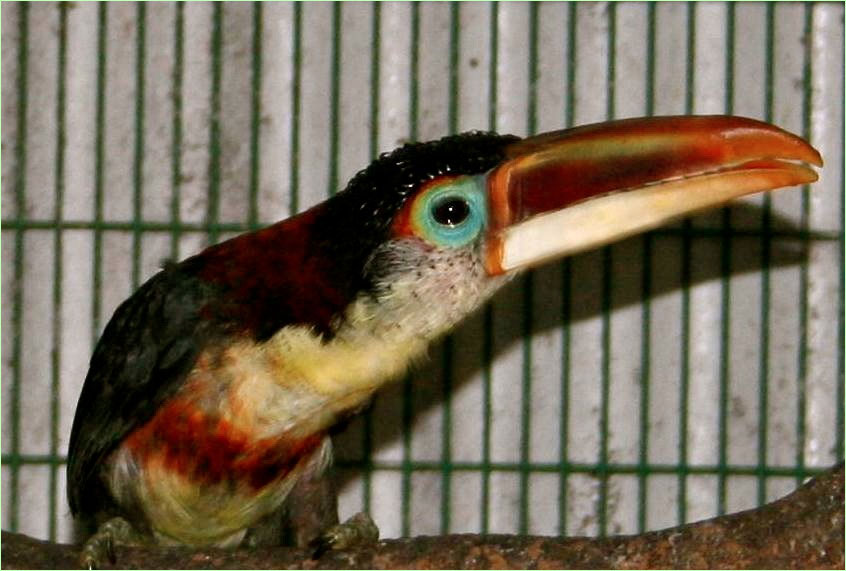
|
Curl-crested Aracari male |
The Toucan’s beak is a light, porous structure rich in blood vessels, internally similar to the smaller beaks of other softbills. Like all birds, the Toucan has no sweat glands and they must pant when overheated, using the evaporation of moisture inside their open mouth as a cooling mechanism. The Toucan has a real problem regulating its body temperature because it dwells in the hot, humid rain forests of Central and South America, where evaporation is slow and a difficult process. Its plumage consists of fine, almost fur-like feathers, which can act like an insulating blanket. The Toucan’s answer to this dilemma seems to be the development of a long beak with a broad internal surface area, allowing the blood circulating inside to cool more efficiently as the bird gapes or pants. There seems to be a rough correlation between habitat and bill size. The larger Toucans of the genus Ramphastos live in the hotter jungle regions, while the smaller, shorter-billed Toucanets generally inhabit the cooler mountain slopes. This trend reflects the need for greater heat loss, hence the larger bills dwell in the hotter, more humid sea-level rainforests. There is an opinion the beak is an example of protective coloration, a theory which has been applied at one time or another to every unexplained bit of plumage or oddities in the class Aves. Upon closer examination, the actions of a Toucan usually defeat any such purpose because at the first sign of danger, the Toucan almost invariably begins to bob about on its perch and croak loudly, advertising its presence to all within a half a mile radius. Protective coloration is useless to an animal who can’t sit still. Another theory is that the bill evolved for purposes of identification. In the field, some species can hardly be distinguished from one another unless the bill is visible. The Keel-billed and the Chesnut-mandibled (Swainson’s) are examples of Toucans that look very similar. The Toucan itself doesn’t use this tool for recognition any more than humans might use the shape of the nose to help recognize one another. Recent studies suggest that the beak developed before the markings. In the genus Ramphastos, the most primitive species, the Red-breasted Toucan has a dull green bill, while the colorful patterns run riot on the beaks of more advanced species such as the Keel-billed. Species recognition in that case is almost certainly a secondary function of the overgrown bill. While it could appear that the bill is a convenient feeding device, it seems that the slender more easily negotiated beak, like that of an Ibis would work with more ease. If you watch a Toucan eat, they go through many wild acrobatics necessary to feed themselves with their unwieldy beaks. Hard to imagine anyone would consider this appendage a dinner-time advantage. The long beak is an adaptation that allows the bird to reach deep into the tree hole and thereby access food unavailable to birds that would otherwise compete for similar food resources. Toucans can also reach further out on a limb for fruit, cut the fruit up with their bill’s serrated edges and house extra-long tongues with more taste buds on them. Occasionally a Toucan or Toucanet will knock itself clear off its perch while fighting a morsel into position for swallowing. Another interesting theory is that the long bill evolved for use in battle is imaginative but perhaps an opinion derived from observing avicultural specimens, instead of what really takes place in the wild. While breeding pairs of captive Toucans have been known to injure and even kill their aviary companions, events such as this are rarely ever reported in nature, where there is more room for a potential victim to flee the clumsy Toucan. Wild, adult Toucans are almost never attacked by predators, so they are rarely observed using their fearsome-looking weapons employed in actual fighting. A Toucan will rely on bluff, or perhaps feinting but not actually striking. Given the fragility of the beak structure, it is probably just as well that it is seldom pressed into service as a bludgeon. >>More |
|
Copyright © 2011, Susie Christian |
